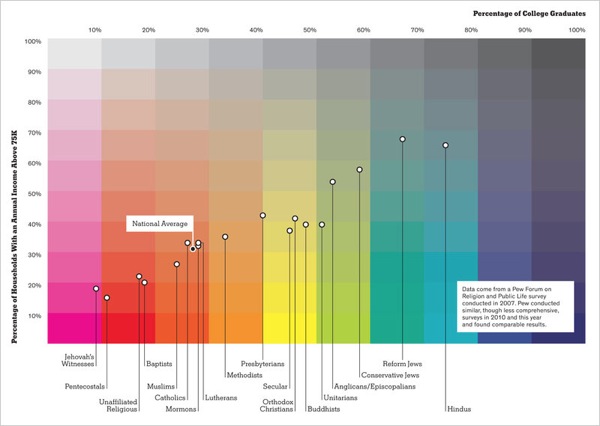Heaven Forbid the New York Times include Atheists
In “Is Your Religion Your Financial Destiny?,” the New York Times presents the following chart of income versus religion:

Note that it doesn’t include the non-religious, which one might think an interesting group as a control. Now, you might think that’s because the non-religious aren’t in the data set. But you’d be wrong. In the data set are atheists, agnostics and “nothing in particular.” That last includes 6.3% of the population as “secular unaffiliated” and another 5.8% as “religious unaffiliated.” Now, 6.3% is more than all non-Christian religions combined. Many of those non-Christian religions are shown in the graphic. Athiest, at 1.6%, is almost as large as Jewish, a major focus of the article, and 4 times larger than Hindus.
Now, you might also argue that athiests were left out because there were too few in the sample (as opposed to demographic data.) But there were 439 athiests, and 251 reform Jews.
Chris Wyspoal pointed out that atheists land after Hindus and Jews for 75k+ incomes.
All the news that’s fit to print, indeed.
Aside from the total failure to cover the 1/6th of the population who are unaffiliated, there’s a whole stack of other things wrong with this chart.
Firstly, we are treated to a scatter that implies a very strong correlation but the strong correlation that appears is in fact one between income and college graduation.
Next, there is also no accounting for the fact that the geographic distribution of both income and religious affiliation are uneven. There are a lot of Hindus in Silicon Valley and a lot of Jews, both reform and conservative, around New York, and both of these places tend to have higher average incomes. Meanwhile Utah doesn’t have inflated salaries and does have a lot (majority, even) of Mormons, and the deep South has both a lot of Baptists and relative poverty.
They chose to plot household income, which is indeed correlated to standard of living, but it would be interesting to also see a plot of iper-capita income. Do single Mormons actually do quite well for themselves but the tendency for wives not to work brings down the household income?
Religion correlates to a whole stack of things including geography and social background. Those factors also correlate well with things like going to college and income levels in any given job. I suspect that it is those, not the religion, that effect the income level.
I can see both “Unaffiliated Religious” (third from the left) and “Secular” (in the yellow column) – presumably thats where they grouped atheists, agnostics and “secular unaffiliated”.